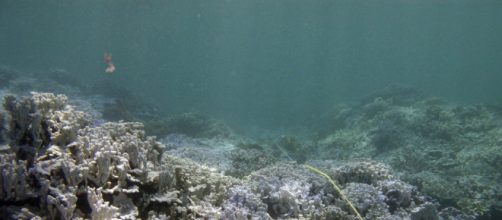The estimation that around 8 billion metric tons of Plastic waste are released into our oceans every year is not new news. What is new is that plastic – sea turtle killer, ocean poisoner, entangler of seabirds – has found a new way to destroy our oceans from the inside: It is now mimicking a Food Source for tiny ocean inhabitants such as plankton and coral, and thus putting a whole host of new problems on the menu for our oceans.
A new study
That these tiny sea organisms that eat plastic have been observed by scientists for some time. However until recently, it had been assumed by biologists and conservationists that this was by accident, rather than design.
But a new study by marine scientists at Duke University, published in the Marine Pollution Bulletin has shown that coral responds to plastic as if it was food. Tests showed that coral was unmoved by other debris drifting in its direction but responded enthusiastically when plastic floated into its vicinity, ‘catching’ it with its cellular harpoon guns (cnidoblasts) and greedily gobbling it up. Scientists believe that this reaction is because one or several of the myriad additives that make up plastic are somehow ‘tasty’ to coral.
Most of the time, the coral realised its mistake and spat out the ingested plastic within six hours. As well they might, for plastic should not form part of the daily diet of the humble coral, seeing as it is almost completely indigestible, leads to internal blockages, creates a false sense of satiety that can mean the coral has no appetite for actual food and, of course, is full of chemicals that are unlikely to promote good health.
This, of course, is a calamitous turn of events for coral, but its potential impacts belie the diminutive size of these tiny plastic guzzlers. For Coral Reefs are a vital part of the marine ecosystem, providing a home, nursery, and sometimes food source for a wide array of marine life. There is a reason why coral reefs are called ‘the rainforest of the sea’ and this is a delicate ecosystem that humans very much rely on for food.
Human activity threatens the marine ecosystem
However, plastics aren’t the only thing troubling the coral reefs. Hurricanes for example, have a destructive impact on corals as they move sediments around. This was the case after Hurricane Irma, which devastated Florida’s coral reefs, with consequences that will likely be felt for years.
Massive storms exacerbate coral bleaching, in which coral reefs expel the algae living on them, causing the coral to turn white and starve.
Human activity has had a serious impact on the ecological balance. Over-fishing near coral is leading to trawl nets damaging the ocean floor, breaking polyps off the reef and fundamentally altering the ecosystem which coral is a part of. Even well-meaning tourists are playing their part in ‘loving to death’ coral reefs, with careless anchoring near corals causing damage and introducing infection and toxins. Coral polyps and their algae, for example, are extremely sensitive to the UV blockers in sunscreen. Even a small amount can kill off a surprisingly large piece of reef.
This process of ‘deforestation underwater’ is starting to gain attention and unfortunately, you don’t need to look far before finding a catastrophic example of coral death. The world’s most famous coral, the Great Barrier Reef, has experienced up to 50% mortality in parts. And it’s not alone. In the year up to March 2016, around 12% of the world’s coral was bleached, due to El Nino and climate change; the longest global coral die-off on record.
Plastics manufacturers need to take responsibility
It’s not all doom and gloom, however, as environmentalists and their supporters have been mobilised to take steps to protect the coral. The Philip Stephenson Foundation, for example, recently created the first coral nursery near Petit St.
Vincent in the Caribbean. There, ‘coral gardeners’ are maintaining the nursery of Elkhorn Corals, which are growing at a rate of 6cm per year.
Similarly, in Florida, the Coral Restoration Foundation has had success in bringing back two particular species, elkhorn and staghorn corals, which had become all but extinct in its waters. This, said Kayla Ripple, the manager of the science program at Foundation, is proof that “People shouldn’t just throw their hands in the air and say there’s nothing we can do”.
And she’s quite right. There’s a great deal that humans can do to save the world’s coral. However, we shouldn’t be relying on remedial action taken by environmental foundations, but actively doing more to prevent these issues occurring in the first place.
Widespread action needed
Tackling the proliferation of plastic in our oceans – 95% of which pours in from just 10 rivers, eight of which are in Asia – would be a start. And the best way to do this is tackle the source: the companies producing plastic. Without widespread action, global plastic production will continue to rise, reaching 500 million tons a year by 2020. We need to disincentivise the producers of plastic from creating quite so much of the stuff by requiring the corporations who manufacture or distribute plastic to take responsibility for recycling 100% of their production and distribution.
Unlike coral, we humans know that plastic isn't good for our environment and therefore isn’t good for us. It’s about time we started doing something about it.


